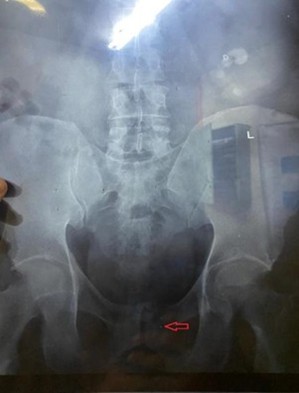Case Report
Prostatic Cavity Stones Following Cystolitholapaxy with TURP: A Rare Postoperative Complication
- Layth Al-Karaja
Corresponding author: Layth Al-Karaja, Faculty of Medicine, Al-Quds University, Jerusalem, Palestine.
Volume: 2
Issue: 5
Article Information
Article Type : Case Report
Citation : Ward Basalat, Seham Madaka, Saeda Abu Sneineh, Layth Al-Karaja, Laith B. Nassar, Khaled alhashash, Diya Asad, Asala Mohammad Awaysa. Prostatic Cavity Stones Following Cystolitholapaxy with TURP: A Rare Postoperative Complication. Journal of Medical and Clinical Case Reports 2(5). https://doi.org/10.61615/JMCCR/2025/AUG027140831
Copyright: © 2025 Layth Al-Karaja. This is an open-access article distributed under the terms of the Creative Commons Attribution License, which permits unrestricted use, distribution, and reproduction in any medium, provided the original author and source are credited.
DOI: https://doi.org/10.61615/JMCCR/2025/AUG027140831
Publication History
Received Date
13 Aug ,2025
Accepted Date
26 Aug ,2025
Published Date
31 Aug ,2025
Abstract
Background
Prostatic cavity stones, also termed utricular stones, are extremely uncommon complications that may arise after combined cystolitholapaxy and transurethral resection of the prostate (TURP). Such cases remain scarcely described in the literature. We report a unique presentation of residual stones forming within the prostatic cavity following this combined procedure.
Case Presentation
A 55-year-old man with a long-standing history of recurrent nephrolithiasis and multiple urological interventions presented with persistent lower urinary tract symptoms (LUTS) despite undergoing cystolitholapaxy with partial TURP. Follow-up imaging revealed residual calculi lodged within the resection cavity of the prostate. The patient experienced recurrent urinary retention and dysuria requiring further interventions. This illustrates a rare but important complication of combined procedures.
Conclusion
Formation of prostatic cavity stones post-TURP and cystolitholapaxy is exceptionally rare. Clinicians should remain vigilant for atypical postoperative symptoms, and careful evacuation of stone fragments during surgery is critical to prevention.
►Prostatic Cavity Stones Following Cystolitholapaxy with TURP: A Rare Postoperative Complication
Ward Basalat1, Seham Madaka2*, Saeda Abu Sneineh3, Layth Al-Karaja2, Laith B. Nassar1, Khaled alhashash1, Diya Asad2, Asala Mohammad Awaysa2
1Rafidia governmental hospital, Nablus, Palestine.
2Al-Quds University, Jerusalem, Palestine.
3National Pirogov Medical University, Vinnytsia, Ukraine.
Background
Transurethral resection of the prostate (TURP) remains the gold standard surgical approach for benign prostatic hyperplasia, while cystolitholapaxy is a well-established procedure for bladder stone clearance. In certain cases, these procedures are performed simultaneously when bladder stones coexist with prostatic obstruction. Although both interventions are widely practiced and generally safe, unusual sequelae may arise. One such complication is the formation of prostatic cavity stones, also known as prostatic utricular calculi, within the surgically resected prostate fossa. This phenomenon is scarcely reported in medical literature and may mimic other common postoperative complications such as bladder neck contracture or recurrent bladder calculi. Herein, we present a case where prostatic cavity stones developed following cystolitholapaxy with TURP, emphasizing diagnostic challenges and lessons for prevention.
Case Presentation
A 55-year-old male with recurrent renal stones and multiple interventions, including percutaneous nephrolithotomy and lithotripsy between 2007 and 2015, presented in 2022 with recurrent urinary tract infections, dysuria, and frequency. Imaging revealed multiple urinary calculi. In 2023, he underwent cystolitholapaxy for bladder stones. During the procedure, an enlarged prostate was identified, and a partial TURP was performed simultaneously.
Postoperatively, the patient developed recurrent urinary retention, initially managed with suprapubic catheterization. Ultrasound and X-ray imaging revealed left hydronephrosis with renal stones, as well as residual radio-opaque calculi within the prostatic fossa (Figure 1). Although cystoscopy did not detect these stones initially, further evaluation confirmed their presence within the resection cavity. The patient required repeated visits to the emergency department for urinary retention and was later managed with additional endoscopic interventions, which improved symptoms, though some residual prostatic cavity stones persisted

Figure 1: KUB Showing Residual Stones within the Prostatic Cavity (Red Arrow)
Discussion
The synchronous management of bladder stones and benign prostatic enlargement with cystolitholapaxy and TURP is considered both safe and effective. Literature supports its role in reducing the recurrence of stones and addressing bladder outlet obstruction. However, our case illustrates that stone fragments left behind during surgery may become trapped within the resected prostatic cavity, ultimately forming calculi. This outcome is rarely described but can significantly affect quality of life due to persistent LUTS and repeated hospital admissions.
While typical complications of TURP include urinary tract infection, hemorrhage, retrograde ejaculation, and bladder neck contracture, the development of cavity stones remains exceptional. Their detection may be challenging since standard cystoscopy or ultrasound may fail to visualize them. In our case, plain radiography (KUB) provided a critical clue for diagnosis. This highlights the importance of considering simple imaging modalities when patients continue to experience symptoms despite apparently normal advanced imaging.
Preventive measures are essential. Complete clearance of stone fragments using an Ellik evacuator during surgery is recommended to reduce the risk of nidus formation within the prostate. Additionally, close postoperative monitoring and maintaining a high index of suspicion for unusual causes of persistent LUTS are crucial.
Conclusion
Prostatic cavity stone formation following combined cystolitholapaxy and TURP is an uncommon but clinically significant complication. It should be suspected in patients with persistent urinary symptoms despite apparently successful surgery. Attention to meticulous intraoperative clearance and vigilant postoperative follow-up can minimize the risk and improve outcomes.
Abbreviations
BPH – Benign Prostatic Hyperplasia
TURP – Transurethral Resection of the Prostate UTI – Urinary Tract Infection
LUTS – Lower Urinary Tract Symptoms
PCNL – Percutaneous Nephrolithotomy
Competing Interests
The authors declare no competing interests.
- Taha DE. (2021). Prostatic resection cavity large stone post transurethral resection of the prostate (TURP): A rare case scenario. Int J Surg Case Rep. 81: 105726.
- Wang K, Ge J, Han W. (2022). Risk factors for kidney stone disease recurrence: a meta-analysis. BMC Urol. 22(1): 62.
- Mekke S, Roshani H, van Zanten P. (2021). Simultaneous TURP and cystolithotripsy: a urological dilemma. Can Urol Assoc J. 15(7): 361-365.
- He K, Liu Y, Li D, Yu Q. (2021). Combination TURP and ureteroscopy for BPH and calculi. Transl Androl Urol. 10(8): 3395-3401.
- Geremew LM, Gelaw SA, Beyene AD. (2022). Complications of TURP graded by Clavien-Dindo system. Ethiop J Health Sci. 32(3): 605-612.
Download Provisional PDF Here
PDF




p (1).png)




.png)




.png)
